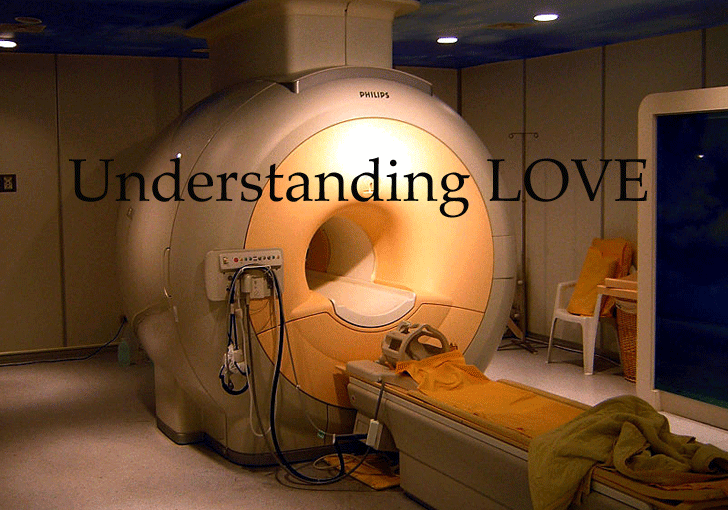
by Gary Vey (http://viewzone.com/love.html)
Are you in love right now?At any given time, about half of all adults admit to being "in love". Most of us would say that love is a wonderful feeling -- something we need -- yet an equal number of us have been hurt, or will be hurt, by love.
For such a common and powerful emotion, most people know very little about the origin, nature and function of love. Hopefully, this story about the latest brain research will change that.
Love has been the subject of novels, movies and dreams. Sometimes it is all we can think about. Love has also been the focus of neuroscientists who have been watching love for over a decade using powerful Magnetic Resonance Imagers (MRI) that reveal networks and activity in the brain with colorful 3-D digital computer images.
A functional MRI detects changes in blood flow to different parts of the brain, which reflect the degree of brain activity in those areas.
By comparing the fMRI patterns for the different kinds of love (there are five) it is possible to see similarities and differences in their centers of activity and neural wiring.
I'll attempt to summarize some of these fMRI scans showing the variety of brain centers that are activated with the different kinds of love. You will see evidence that falling in love is no random act, that some relationships are doomed to fail and that an entire brain system exists to keep you happily attached to your mate... if you can manage to turn it on.
The Different Kinds of Love
There are five types of love: Altruistic Love, Maternal Love, Sexual Love, Romantic Love and Attachment Love. Of course, you are understandably more interested in the last three kinds of love, so let's get the first two out of the way.
Altruistic Love
The edict of most religions commands that we "love" our neighbor. Some philosophers have argued (Kant and Kierkegaard come to mind) that this kind of neighborly love excludes not only sexual and romantic love, but friendship as well. They argue that altruistic love should be distributed equally and without preference. Having a "special someone" is not part of the deal and, they argue, it is prohibited.
Other philosophers argue that altruistic love is not really love at all, but a form of respect. You must respect someone before you love them but respect does not always evolve into love.
Not many people can adhere to long periods of altruistic love, unless you are, for example, a Tibetan monk. These monks devote their lives to practicing non-attachment and fostering compassion without preference. They are the epitome of altruistic love.
Neuroscientists have recently measured the brain activity of Tibetan monks in an MRI machine at the UC Davis Center for Mind and Brain during which time they were asked to express (feel) compassion[3].

[Above left:] Magnetic Resonance Image (MRI) of a Monk's brain during meditation when he was asked to actively "extend compassion". Not surprisingly, the medial prefrontal cortex was activated -- an area usually associated with empathy and The Theory of Mind. Activity is most pronounced in the area associated with processing "rewards" [5].
[Above right:] A different view of the same MRI showing activity in the striatum, another area also associated with processing "rewards". We will encounter the striatum again with other kinds of love.
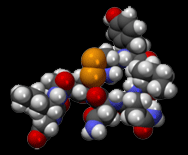 When neuroscientists say that an area is processing "rewards", they mean that some behavior has triggered the release of euphoric hormones like oxytocin, vasopressin or dopamine. It strongly suggests that the brain has been wired to respond positively to certain thoughts or behavior -- most often, but not always, to our benefit.
When neuroscientists say that an area is processing "rewards", they mean that some behavior has triggered the release of euphoric hormones like oxytocin, vasopressin or dopamine. It strongly suggests that the brain has been wired to respond positively to certain thoughts or behavior -- most often, but not always, to our benefit.
The striatum is an area of the brain especially rich in oxytocin and dopamine innervation. It not only rewards us with euphoria when we successfully achieve our craving (i.e. food, drink, sex) but it rewards behavior that will eventually lead to satisfying our needs. Think about the bell in Pavlov's experiments with feeding dogs. The significance of this will soon become apparent.
Let's take a look at four main ingredients in love.
- Oxytocin has been called the brain's "love hormone" because it is intimately involved in sexual arousal, pair bonding and orgasmic pleasure. When your brain gets a hit of oxytocin it shuts down or inhibits the mental processes that produce anxiety, fear, restricted behavior and negative emotions. All that's left is good, and that's exactly how you feel[4].Oxytocin is responsible for bonding, monogamy, parenting -- any activity that requires close association with another individual. It can selectively shut off suspicious emotional areas of the brain, promoting friendships and trust.
- Vasopressin is a chemical with many similarities to oxytocin. It regulates the release of water by the kidneys and maintains blood pressure by constricting the blood vessels and making the heart beat faster. In the brain, it is the energy that drives sexual pleasure prior to orgasm. Vasopressin seems to work with oxytocin, often modulating its effects.
- Serotonin is a neurotransmitter that, when low, causes obsessive thoughts and behavior. It lowers when one "falls in love" and contributes to obsessive thoughts of the beloved during Romantic love.
- Dopamine is a neurotransmitter that drives the brain's reward and pleasure centers. In short: dopamine binding with a dopamine receptor produces the feeling and perception of pleasure.Once an action or behavior has triggered the dopamine rush, the mind begins to seek ways to continue or repeat the behavior. The dopamine system enables us not only to see and recognize goals in our environment, but motivates us to take action to move toward them.
In studies of gamblers, cocaine users and even people playing computer games for small amounts of money, these dopamine sites become extremely active as people score or win, neuroscientists say.
In the case of the Tibetan monks, it appears that compassion and altruistic love have some pleasant emotional benefits from of stimulated oxytocin neurons in the striatum. Buddhism is a very difficult discipline but the brain's altruistic love network provides a means of mediating the sacrifices of non-attachment and austerity with a neurochemical happiness.
Maternal Love
Back in the 1950s Henry Harlow conducted his famous experiments about maternal love on Rhesus monkeys. He demonstrated that the bond between mother and child begins immediately after birth and is vital to the infant's ability to develop social and sexual bonding as an adult.
Harlow's Experiment
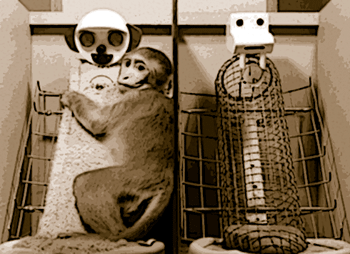 Rhesus monkeys were immediately separated from their biological mother at birth. They were raised by two man-made dolls, barely resembling a mother monkey. One mother was made out of bare wire mesh while the other was a cardboard and foam rubber mother covered with soft terry cloth. Rhesus monkeys were immediately separated from their biological mother at birth. They were raised by two man-made dolls, barely resembling a mother monkey. One mother was made out of bare wire mesh while the other was a cardboard and foam rubber mother covered with soft terry cloth.Both dolls were capable of dispensing milk through a nipple which could be turned on and off. Harlow's first observation was that monkeys who had a choice of both mother dolls spent more time clinging to the terry cloth surrogates, even when their milk came from nipples on the bare wire mothers. When the infants were separated into two groups and assigned either a wire frame or terry cloth mother, they all drank and ate equal amounts of food and grew at the same rate. But there were some striking differences when each group faced stress. When faced with a loud teddy bear beating a drum, monkeys who had soft, terry cloth mothers made bodily contact with their mothers, rubbed against them, and eventually calmed down. Harlow theorized that they used their mothers as a "psychological base of operations", allowing them to remain playful and inquisitive after the initial fright had subsided. In contrast, monkeys raised by wire mesh surrogates did not retreat to their mothers when scared. Instead, they threw themselves on the floor, clutched themselves, rocked back and forth, and screamed in terror. Harlow noted that these activities closely resembled the behaviors of autistic and deprived children frequently observed in institutions as well as the pathological behavior of adults confined to mental hospitals. This confirmed for Harlow the belief that maternal love involves intimate contact between mother and child and that this need is greater than just providing nourishment. But there were some more surprises to come. When he took the grown-up cloth-mothered monkeys out to play and mate, they were violently antisocial. Some began to display autistic-like behavior. A New York Times reporter came out to Madison to do a follow-up and Harlow led him to his lab, where a troop of rocking, head-banging macaques sat in cages, chewing off their fingers. "I admit it," said Harlow. "I have made a mistake."And so he set out to correct it. Mothering, he hypothesized, must have other variables, such as motion. So he made a surrogate that could rock. [source] |

[Above:] fMRI Scan for subjects viewing a photograph of their child and experiencing maternal love. The main activated areas are the striatus (caudate and putamen), insula, and ACC. These areas are involved in the reward system and are rich in oxytocin, vasopressin and dopamine circuitry.
The most important ingredient in maternal love appears to be oxytocin's ability to shut off certain areas of the brain that usually contribute negative ideas and uncomfortable feelings and would otherwise be critical of the beloved's behavior. The mother can see no bad in her child and the infant only knows good from its mother (even when she is made from cloth).
An example of an oxytocin inhibited brain region is the putamen (part of the striatum) which is capable of very negative thoughts.
Recent, tentative studies have suggested that the putamen may play a role in the so-called "hate circuit" of the brain. A recent study was done in London by the Department of Cell and Developmental Biology at University College London. An fMRI was done on patients while they viewed a picture of people they hated and people who were "neutral". During the experiment, a "hate score" was recorded for each picture. The activity in sub-cortical areas of the brain implied that the "hate circuit" involves the putamen and the insula. It has been theorized that the "putamen plays a role in the perception of contempt and disgust, and may be part of the motor system that's mobilized to take action." [source]
By varying the amount of oxytocin in experimental animals (rats and voles), neoroscientists have been able to turn on and shut off maternal behavior (aggressively protecting their infant, cuddling and nursing) that is usually associate with maternal love. If similar systems operate in the human brain then perhaps bad maternal skills can be attributed to a mother's own lacking of maternal love -- touch, motion and play -- as an infant.[8][9]
When asked about the significance of mother-infant bonding for the human infant, Harlow estimated that this process, the ability to bond with another, is irreversibly established in the first six months of life. It is thought that oxytocin receptors and neurons develop (or fail to develop) in this period. A lesser number of these receptors (and lower oxytocin) would mean being less able to quiet brain centers that produce fear, anger, hatred and distrust. This would produce anti-social behavior in adults.
The inability to be a "sensitive parent" has been linked with decreased oxytocin receptors. [16]Likewise, mothers with high attachment were found to have more oxytocin than less attached mothers. [22] Mothers who were deprived of maternal love will neglect their own offspring, perpetuating the dysfunction.
We need to remember that Harlow's experimental "mother" was inanimate and incapable of maternal love. But that infant "perceived" the comfort of the terry cloth doll as maternal love. The brain was tricked... by love.
New Theory on Why Men Love Breasts
 Why do straight men devote so much headspace to those big, bulbous bags of fat drooping from women's chests? Scientists have never satisfactorily explained men's curious breast fixation, but now, a neuroscientist has struck upon an explanation that he says "just makes a lot of sense." Why do straight men devote so much headspace to those big, bulbous bags of fat drooping from women's chests? Scientists have never satisfactorily explained men's curious breast fixation, but now, a neuroscientist has struck upon an explanation that he says "just makes a lot of sense."Larry Young, a professor of psychiatry at Emory University who studies the neurological basis of complex social behaviors, thinks human evolution has harnessed an ancient neural circuit that originally evolved to strengthen the mother-infant bond during breast-feeding, and now uses this brain circuitry to strengthen the bond between couples as well. The result? Men, like babies, love breasts. When a woman's nipples are stimulated during breast-feeding, the neurochemical oxytocin, otherwise known as the "love drug," floods her brain, helping to focus her attention and affection on her baby. But research over the past few years has shown that in humans, this circuitry isn't reserved for exclusive use by infants. [source LiveScience] |
Lust, Romance and Attachment: Shifting Goals
The last three kinds of love, Lust (sexual) love, Romantic (obsessive) love and Attachment (friendship) love are often not distinguished when we speak of "loving" someone. Although each kind of love is driven primarily by a different reward hormone, the systems seem to be hard wired to cooperate with each other automatically.
Sexual love motivates our interest in a subset of potential mates, depending on age and availability. The hypothalamus plays a role in gender preference. Romantic love selects a lover and obsesses over them. Finally, Attachment love incorporates the beloved into our world view and self identity.
Lust (Sexual) Love & Desire
Sexual love begins with hormones like testosterone in both men and women [12]. Athletes taking testosterone for strength and fitness report more sexual thoughts and more morning erections. Middle aged women who use topical testosterone cream report increased sex drive. The effects of these natural sex hormones are hard wired and serve the greater needs of procreation and species survival.
Oxytocin also plays a role in sexual arousal. Oxytocin injected into the cerebrospinal fluid causes spontaneous erections in rats, reflecting actions in the hypothalamus and spinal cord. [15] During arousal, oxytocin inhibits areas of the brain that produce negative thoughts and foster distrust and fear.
Through the libido, sexual hormones energize our body with triggered releases of adrenaline and norepinephrine, increasing our heart rate and creating a state of arousal which triggers the dopamine. This pleasurable neurotransmitter provides the drive to find the objective of desire and achieve the most intense neuro-chemical reward of sexual contact and orgasm.
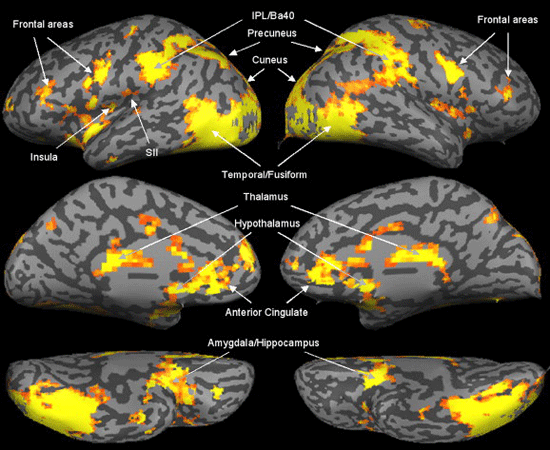
[Above:] Combined MRI and Positron Emission Tomography (PET) scans for healthy heterosexual males during penile erection and sexual arousal. Activation is in many areas (anterior cingulate, insula, amygdala, hypothalamus, and secondary somatosensory cortices) rich in dopamine innervation and are located mainly on the right side of the brain.[11]
The finding that the cortical activations are found almost exclusively on the right side of the brain corresponds with the results of researchers who reported that the frequency of sexual dysfunction is significantly higher after CVAs (strokes) in the right rather than left hemisphere. [12]
The posterior of the brain shows activity in the visual centers, likely because the erotic stimulus for the experiment involved visual images.
The reward of orgasm triggers all four neuro-chemicals of love along networks that extend throughout the brain. Below is a short video showing the activated networks during a female orgasm.
Female orgasm captured in series of brain scansMonday, November 14, 2011 - 16:32 in Psychology & Sociology
To make the animation, researchers monitored a woman's brain as she lay in a functional magnetic resonance imaging (fMRI) scanner and stimulated herself. The research will help scientists to understand how the brain conducts the symphony of activity that leads to sexual climax in a woman. [source] |
During orgasm, blood flow decreases to all regions of the cortex except the prefrontal cortex, where it increases.[13] This is an area rich in dopamine neurons. The brain is literally showered with dopamine pleasure.
The dopamine reward system is so powerful that it stimulates the desire and planning for repetition and more accessibility to the love object. In some animals, sexual orgasm establishes a pair-bond which serves the protection and survivability of their offspring by rearing them as a couple.
"When the female laboratory-maintained prairie vole (Microtus ochrogaster) is mated with a male, she forms a distinct preference for him, associated with a 50% increase of dopamine in the nucleus accumbens. When a dopamine antagonist is injected into the accumbens, the female no longer prefers this partner; and when a feamle is injected with a dopamine agonist, she begins to prefer the conspecific who is present at the time of infusion, even if she has not mated with this male. [19]
Humans have been provided with a similar system to promote pair bonding, based on oxytocin which initiates the next phase: falling in love.
Falling In (Romantic) Love
At least two uncontrolled studies have found increases in plasma oxytocin at orgasm -- in both men and women.[14][17] This reveals natures attempt to encourage bonding following sexual intercourse. High levels of oxytocin remain for only 30 minutes, then fall to normal. This suggests that the time immediately following orgasm, when oxytocin levels are at their peak, is the optimal time for bonding, intimacy and cuddling.
The prevailing view of neuroscientists, notably Helen Fisher, is that process of "falling in love" is a neuro-chemical event that reportedly takes about a fifth of a second to occur [15]. The neural pathways controlling this phenomenon are hard wired and driven by the reward system.
Every species has examples of romantic love. Animals have a preference and decide with whom they will mate and bond. We don't know why a particular partner is chosen from many similar possibilities but some believe that we select mates based on our similarities in the levels of various neuro-chemicals, somehow determined by behavior [15]. Previous studies have implicated pheromones -- unique scents given off in perspiration -- that reveal compatible and complimentary immune systems -- which benefit the offspring [21]. To date, we just do not know why we fall in love with our partners.
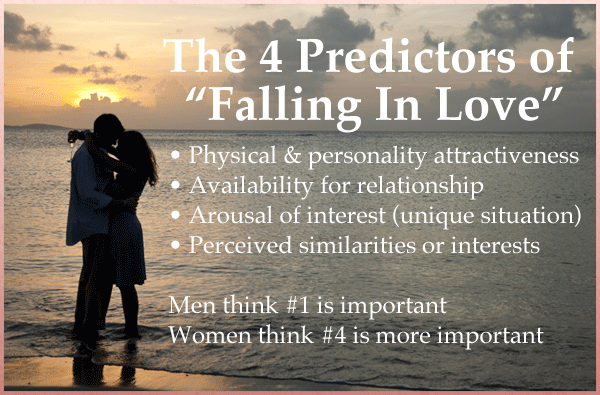
[22]
While confirming the major role of oxytocin, professor Stephanie Ortigue from Syracuse University noted that falling in love is not only instantaneous but it can elicit the same euphoric feelings as cocaine because both share the same reward system.
Oxytocin can inhibit intellectual areas of the brain, especially those that would be critical of the beloved, making us "love blind". Addicts have the same tendency to self-deceive and rationalize their continued drug use, despite knowing it is harmful to them. There is a growing belief that Romantic love is even more addictive than opiates. It has the three qualities of addiction: tolerance, withdrawl and relapse.
Oxytocin release during Romantic love lowers serotonin which can cause confusion and obsessive thoughts about the beloved. These same brain centers are responsible for obsessive-compulsive disorders (OCD).
Although it has been successful with animals, there have been few published experiments where humans were given oxytocin, then watched to see if they bonded with a nearby mate. Such things, although unethical, have almost certainly been attempted. Artificially raising the brain's oxytocin would be the recipe for a real "love potion" with regards to bond forming.
Oxytocin is degraded when ingested. It can be injected into the blood stream but it will not cross the blood brain barrier. Aside from injecting it into spinal fluid, the only way of introducing oxytocin to the brain is through a nasal spray. And now we have just that... con-artists and gigolos take notice.

"Researchers now report they can boost oxytocin in the human brain using a nasal spray. And when they do, trust seems to rise and social fear seems to abate, raising the possibility that oxytocin-based drugs might eventually help people with mental illnesses that involve fear of others, from crippling shyness to autism and schizophrenia.This month, Meyer-Lindenberg and others reported in The Journal of Neuroscience that when young men snorted oxytocin, brain scans showed that fear centers became less responsive to threatening faces.The journal Nature recently published research showing that when subjects played a game that hinged on trust, those who had snorted oxytocin were more likely to trust other players.
[source]
Falling in love releases Nerve Growth Hormone (NGH)
 In 2005, Enzo Emanuele and coworkers at University of Pavia found that nerve growth factor (NGF) has high levels when people first fall in love, but these levels return to as they were after one year. To be specific, four neurotrophin levels of 58 subjects who had recently fallen in love were compared with levels in a control group who were either single or already engaged in a long-term relationship. The results showed that NGF levels were significantly higher in the subjects in love than as compared to either of the control groups. In 2005, Enzo Emanuele and coworkers at University of Pavia found that nerve growth factor (NGF) has high levels when people first fall in love, but these levels return to as they were after one year. To be specific, four neurotrophin levels of 58 subjects who had recently fallen in love were compared with levels in a control group who were either single or already engaged in a long-term relationship. The results showed that NGF levels were significantly higher in the subjects in love than as compared to either of the control groups.Nerve growth factor may contribute to increased longevity and mental capacity. Centenarian Rita Levi-Montalcini [right] took a daily solution in the form of eye drops, and has stated that her brain is more active now than it was four decades ago. NGF prevents or reduces neuronal degeneration in animal models of neurodegenerative diseases and these encouraging results in animals have led to several clinical trials in humans. NGF has also been shown to promote peripheral nerve regeneration in rats. NGF appears to promote myelin repair. Hence NGF may be useful for the treatment of multiple sclerosis. [source wikipedia] |
Moving goals in the striatum
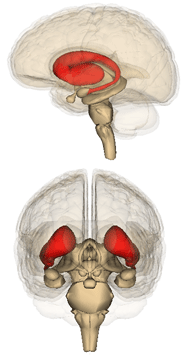 According to a study published in The Journal of Sexual Medicine, Sexual desire and Romantic love activate different areas of the striatum [right].
According to a study published in The Journal of Sexual Medicine, Sexual desire and Romantic love activate different areas of the striatum [right].
The area activated by Sexual Love (desire) is usually activated by things that are inherently pleasurable, such as sex and food. The area activated by Romantic Love is involved in the process of rewarding behavior associated with, but not primarily related to things like sex and food. That is, as feelings of sexual desire develop into love, their processing moves to a different place in the striatum. Call it the "love zone".[15]
As described above, the initial goal of these brain systems is procreation (the sex act), associated with the dopamine-rich orgasm. Driven by mounting testosterone and oxytocin, a realistic means to achieve this goal is undertaken, a probable partner is selected from what is available and we "fall in love".
The oxytocin system continues to stimulate bonding during this Romantic love period and the sex, for a time, maintains pleasurable dopamine levels. Ironically, men's testosterone drops after falling in love, while women's levels go up. For a while, both sex drives are about equal and all is well... But not for long.
Like most addictions, over time the dopamine receptors become numb to the same old stimulus. If the bonding has not been sufficiently established through activities that raise oxytocin levels then the relationship could end.
Bonding provides comfort, safety, security, less anxiety and less fear through the release of oxytocin which inhibits brain centers that usually produce the opposite feelings. Bonding is the behavior that the neural network is hard wired to reward. Bonding also appears to promote health and prolong life.
As dopamine rewards become less intense in a relationship, increased oxytocin throttles down our negative emotions and promotes happiness and trust. Evolutionists say that all of this neuro-chemistry and hard wiring is designed to keep both parents together after mating to better protect and nurture their offspring.
Can there be Romantic Love Without Sex?
Many of us have felt strong feelings of obsessive love without sex -- even without the partner knowing that we existed! But was it really love that we felt? Being infatuated with someone (low serotonin) with whom you have never been intimate is more desire and lust, although it's dressed up a bit. The imagination is capable of consummating sexual love through masturbation or meditation on the love object and the brain (not being able to distinguish the real from imagined) quickly initiates the oxytocin induced bonding, followed by the lower serotonin and resulting obsessive thoughts.
The terry cloth mother in Harlow's monkey experiments reminds us that love can exist in the imagination of the unloved, and still be rewarded.
Overlapping love networks... what can it tell us?
Here are some interesting examples of overlapping kinds of love. With a few exceptions, most of the active regions stimulated by Romantic love are identical to those seen in Maternal love [see below].
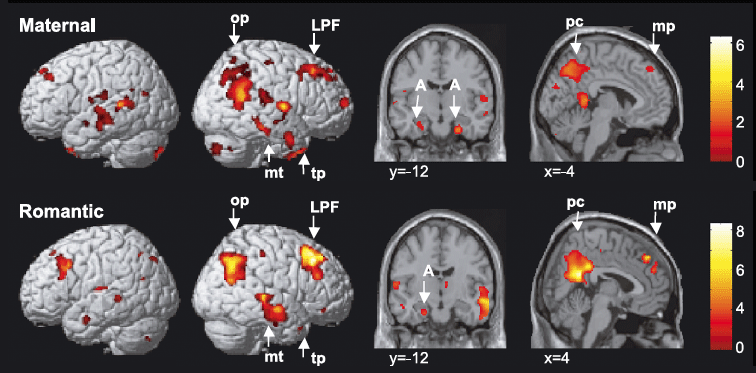
Evolutionary theorists have argued that the system of infant-mother bonding was initially evolved to keep children and parents close for safety and survival. They say that pair bonding between a couple was co-opted for the purpose of keeping reproductive partners together long enough to rear offspring [20]. In other words, adult pair bonding may be an ex-aptation -- a system that originally evolved for one reason, but comes to serve another.
Could this similarity of active regions imply that, like the hypothetical lack of oxytocin neurons in Harlow's experiment, people with deficiencies of Maternal love may also be deficient in their capacity for Romantic love? It seems likely but more work has to be done on this topic.
Attachment Love: Enduring Companionship
The third phase of love is one that must be earned, and at a steep price. Attachment love happens over time as the other tempestuous feelings quiet down. The dopamine hits from sex begin to diminish in their perceived pleasure and the bonding from oxytocin has allowed a great sense of security and trust to become established. In Attachment love, the personality traits and lifestyle of the beloved become incorporated with our own self-identity.
"Love can start off with any of these three feelings. Some people have sex first and then fall in love. Some fall head over heels in love, then climb into bed. Some feel deeply attached to someone they have known for months or years; then circumstances change, they fall madly in love and have sex... The sex drive evolved to encourage you to seek a range of partners; romantic love evolved to enable you to focus your mating energy on just one at a time; and attachment evolved to enable you to feel deep union to this person long enough to rear your infants as a team."
Dr. Helen Fisher [*]
Attachment love is usually seen in long friendships or in couples who have been together for many years. This special kind of love has many advantages and this is no doubt why it has been hard wired in our brains.
Socially, older generations (parents and grandparents) establish the basis of family and clan structure. Older generations are valuable sources of information like history and technology which contribute to survivability. As such, there appears to be a neural pattern associated with long-term pair relationships. It is focused deep in the pre-conscious areas of the brain, like the caudate nucleus and the ventral tegmental area (VTA). These have sometimes been referred to as the "reptilian brain".

[A] When viewing a photograph of their beloved, people in long-term relationships (average 20+ years) had consistent activity in the VTA and caudate [C]. About one in ten long-term relationships had also maintained active regions associated with Lust and Romance, notably in the striatum. Some MRI scans were almost identical to those of new lovers experiencing Romantic love. These couples reported that they felt happier, healthier and (still) deeply "in love". Thehippocampus is where our life memories and self-identity reside. Here it is shown active [D]. Clearly, the "good life" was maintained in the VTA and caudate where dopamine made it so.
 Overall, results suggest that for some individuals the reward-value associated with a long-term partner may be sustained, similar to new love, but also involves brain systems implicated in attachment and pair-bonding.[24]
Overall, results suggest that for some individuals the reward-value associated with a long-term partner may be sustained, similar to new love, but also involves brain systems implicated in attachment and pair-bonding.[24]
Some factors that enabled long-term relationships to flourish were:
1 Not being under great external stress (poverty, sickness, being in a war zone)
2 Neither partner being depressed or anxious
3 Partners having good communications skills
4 Partners regularly doing things together that are exciting, novel, and challenging
5 Partners celebrating each other's successes [source]
Active VTA Means "Life is good!"
 The ventral tegmental area rests on the floor of the midbrain, close to the center. It is the origin of two of the brain's major dopamine pathways: the mesocortical pathway and the mesolimbic pathway. Three other, less significant dopamine channels also have their sources in the ventral tegmental area: the mesodiencephalic, the mesostriatal, and the mesorhombencephalic pathways. When the ventral tegmental area gets messages indicating how and if various needs are being satisfied, dopamine neurons respond appropriately. They become the messaging system by which the ventral tegmental area transmits communication to the nucleus accumbens, another area of the brain that sits in front of the ventral tegmentum. Once in the nucleus accumbens, dopamine levels increase, enhancing pleasurable feelings and thereby "rewarding" the behaviors through which the basic needs are met. [source] |
Love is a Self-Administered Drug
The MRI scans of people in various states of love clearly reveals that this emotion has priority with our neuro-chemical reward system. What is also clear is that these networks of love trigger themselves -- they "happen" to us for reasons that we still do not fully understand. Although it is the most intimate motivator, we have little control over love.
The "imagined" maternal love from an inanimate cloth doll was sufficient, along with movement and play, to enable the monkeys in Harlow's experiments to be successfully nurtured. Virtual dating and chats allows humans to experience "imagined" Romantic love spanning many years. But there seems to be no faking it with long-term relationships and Attachment love. It happens slowly and in the deep realms of the mid-brain where pleasure is born. But there is a danger inherent in this pleasant, emotional long burn.
Breakups... ouch!
Having a long term relationship requires continuous bonding activities to maintain the benefits of oxytocin. The five factors listed above are designed to do that. Drifting apart, intellectually, socially and sexually, diminishes oxytocin and allows centers that process fear and negative thoughts to become active again. Occasional sex may prolong the status quo of a stagnant relationship with blasts of dopamine, but eventually the overall joy dissipates from the relationship and it ends.
Sometimes the relationship ends abruptly over an argument or discovered infidelity or even death. The pain from a long term "breakup" is both physiological and psychological. MRI scans have shown that the centers involved in Romantic love are actually more active immediately following a breakup as the mind "craves" the dopamine loss. Oxytocin levels drop as intimacy wanes. Serotonin levels, already low in Romantic love, cause depression and obsessive thoughts.
Psychologists say that the human mind can rebound from lost love because that "love" was self-generated in the first place. The neural networks remain in place and the neuro-chemicals will eventually normalize. The mind is hard wired for love and it quickly recovers and is eager to start the process over again and again. The best remedy for the anxiety and depression from a breakup is to fall in love again.
What does this mean?
MRI scans demonstrate that there are specific neural pathways for different kinds of love. These pathways influence our behavior by rewarding us for certain behavior. The reward is in the form of neuro-chemicals that make us more relaxed, shut off negative thoughts, rev up our heartbeat and, most importantly, release dopamine -- the pleasure molecule.
Love is the psychological affect of inherent neuro-chemical processes and neural pathways. Love exists in the individual who feels it but not necessarily in the love object. Regardless, the affects of perceived love are as good as the real thing in meeting our brain's basic developmental needs.
Future areas of inquiry might address the MRI of other emotions, such as worship. Do we have a need to worship something? Is it driven by a neurological network?
Notes:[8] Insel and Young, 2001; Pedersen, 1997; Pedersen et al., 1982; Winslow et al., 1993
[9] Ferguson et al., 2000; Insel and Young, 2001; Winslow et al., 1993
[10] http://www.ajnr.org/content/29/10/1890/F3.expansion.html
[11] http://www.sciencedirect.com/science/article/pii/S1053811905001965
[12] Edwards & Booth, 1994; Serman, 1994; Van Goozen, Wiegant, Endert, Helmond & Van de Poll, 1997
[13] Tiihonen et al., 1994
[14] Carmichael MS, Humbert R, Dixen J, Palmisano G, Greenleaf W, Davidson JM (January 1987). "Plasma oxytocin increases in the human sexual response". The Journal of Clinical Endocrinology and Metabolism 64 (1): 27-31.
[15] Gimpl G, Fahrenholz F (April 2001). "The oxytocin receptor system: structure, function, and regulation". Physiological Reviews 81 (2): 629-83.
[16] Stephanie Caloppo, Francesco Blanchi-Demicheli, Chris Frum, James G. Pfaus, James W. Lewis, "The Common Neural Bases Between Sexual Desire and Love: A Multilevel Kernel Density fMRI Analysis," The Journal of Sexual Medicine, 2012; 9 (4)
[17] http://jcem.endojournals.org/content/65/4/738.short
[18] Carmichael MS, Warburton VL, Dixen J, Davidson JM (February 1994). "Relationships among cardiovascular, muscular, and oxytocin responses during human sexual activity". Archives of Sexual Behavior 23 (1): 59-79.
[19] Gingrich, B., Liu, Y., Cascio, C. Z., & Insel, T. R. (2000) Dopamine D2 receptors in the nucleus accumbens are important for social attachment in female prairie voles (Microtus ochrogaster). Behavioral Neuroscience, 114. 173-184
[20] Lisa M. Diamond, "Emerging Perspectives pn Distinctions Between Romantic Love and Sexual Desire", American Psychological Society (2004), Vol 13, No. 3
[21] University of California - Berkeley (2007, February 8). "Male Sweat Boosts Women's Hormone Levels", ScienceDaily Retrieved March 5, 2013, from http://www.sciencedaily.com/releases/2007/02/070207172019.htm
[22] Galperin_Haselton_2010_Predictors_of_falling_in_love.pdf
[9] Ferguson et al., 2000; Insel and Young, 2001; Winslow et al., 1993
[10] http://www.ajnr.org/content/29/10/1890/F3.expansion.html
[11] http://www.sciencedirect.com/science/article/pii/S1053811905001965
[12] Edwards & Booth, 1994; Serman, 1994; Van Goozen, Wiegant, Endert, Helmond & Van de Poll, 1997
[13] Tiihonen et al., 1994
[14] Carmichael MS, Humbert R, Dixen J, Palmisano G, Greenleaf W, Davidson JM (January 1987). "Plasma oxytocin increases in the human sexual response". The Journal of Clinical Endocrinology and Metabolism 64 (1): 27-31.
[15] Gimpl G, Fahrenholz F (April 2001). "The oxytocin receptor system: structure, function, and regulation". Physiological Reviews 81 (2): 629-83.
[16] Stephanie Caloppo, Francesco Blanchi-Demicheli, Chris Frum, James G. Pfaus, James W. Lewis, "The Common Neural Bases Between Sexual Desire and Love: A Multilevel Kernel Density fMRI Analysis," The Journal of Sexual Medicine, 2012; 9 (4)
[17] http://jcem.endojournals.org/content/65/4/738.short
[18] Carmichael MS, Warburton VL, Dixen J, Davidson JM (February 1994). "Relationships among cardiovascular, muscular, and oxytocin responses during human sexual activity". Archives of Sexual Behavior 23 (1): 59-79.
[19] Gingrich, B., Liu, Y., Cascio, C. Z., & Insel, T. R. (2000) Dopamine D2 receptors in the nucleus accumbens are important for social attachment in female prairie voles (Microtus ochrogaster). Behavioral Neuroscience, 114. 173-184
[20] Lisa M. Diamond, "Emerging Perspectives pn Distinctions Between Romantic Love and Sexual Desire", American Psychological Society (2004), Vol 13, No. 3
[21] University of California - Berkeley (2007, February 8). "Male Sweat Boosts Women's Hormone Levels", ScienceDaily Retrieved March 5, 2013, from http://www.sciencedaily.com/releases/2007/02/070207172019.htm
[22] Galperin_Haselton_2010_Predictors_of_falling_in_love.pdf
i havent read it yet but will read it over some wine later tonight
ReplyDelete